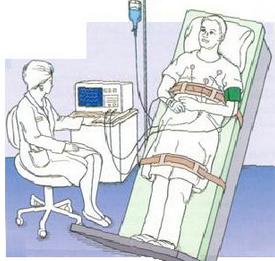Tilt table test

A tilt table test is used to help diagnose forms of dysautonomia such as postural orthostatic tachycardia syndrome (POTS) or neurally mediated hypotension (NMH). Symptoms caused by dysautonomia include dizziness, lightheadedness, or fainting (syncope). Vital signs, especially heart rate and blood pressure are monitored as the table slowly raises the patient from lying to nearly standing position. The patient is strapped to the table in case the patient faints in the upright position. Other conditions that can be diagnosed with a tilt table test is cardiac arrhythmia.[1]
Recommended test for ME/CFS[edit | edit source]
The Institute of Medicine Report recommends a tilt table test for diagnosing orthostatic intolerance in ME/CFS.[2]
Beyond Myalgic Encephalomylitis/Chronic Fatigue Syndrome: Redefining an Illness (2015) pgs. 111-119 covers Tilt Table Test: "Assessment of Orthostatic Intolerance and Autonomic Dysfunction in ME/CFS"[3]
Risks[edit | edit source]
A tilt table test is generally safe, and complications are rare. But, as with any medical procedure, it does carry some risk.
Potential complications include:
- Nausea and vomiting after fainting
- Weakness that can last several hours
- Prolonged low blood pressure (hypotension) after the test
These complications usually go away when the table is returned to a horizontal position.[4]
Research studies[edit | edit source]
- 2018, The Abnormal Cardiac Index and Stroke Volume Index Changes During a Normal Tilt Table Test in ME/CFS Patients Compared to Healthy Volunteers, are Not Related to Deconditioning[5] - (Full text)
- 2020, Cerebral blood flow is reduced in ME/CFS during head-up tilt testing even in the absence of hypotension or tachycardia: A quantitative, controlled study using Doppler echography - (Full text)
- 2020, Cerebral Blood Flow Is Reduced in Severe Myalgic Encephalomyelitis/Chronic Fatigue Syndrome Patients During Mild Orthostatic Stress Testing: An Exploratory Study at 20 Degrees of Head-Up Tilt Testing[6] - (Full text)
See also[edit | edit source]
Learn more[edit | edit source]
- Tilt Table Test[7] - Video short by eMedTV
- Mayo Clinic webpage for Tilt table test
- Tilt Test – Tilt Table Test Explained![8] by Mustafa Ahmed for MyHeart
References[edit | edit source]
- ↑ name="ClevelandClinic">https://my.clevelandclinic.org/health/diseases/6004-dysautonomia
- ↑ "Proposed Diagnostic Criteria for ME/CFS". nationalacademies.org.
- ↑ "Beyond Myalgic Encephalomyelitis/Chronic Fatigue Syndrome". National Academies of Medicine: 111. March 16, 2015. doi:10.17226/19012.
- ↑ "Tilt table test - Mayo Clinic". Mayo Clinic. Retrieved August 27, 2018.
- ↑ van Campen, C. (Linda) M.C.; Visser, Frans (November 2018). "The Abnormal Cardiac Index and Stroke Volume Index Changes During a Normal Tilt Table Test in ME/CFS Patients Compared to Healthy Volunteers, are Not Related to Deconditioning". Journal of Thrombosis and Circulation. 107. doi:10.29011/JTC-107.000007.
- ↑ van Campen, C. (Linda) M.C.; Rowe, Peter C.; Visser, Frans C. (June 2020). "Cerebral Blood Flow Is Reduced in Severe Myalgic Encephalomyelitis/Chronic Fatigue Syndrome Patients During Mild Orthostatic Stress Testing: An Exploratory Study at 20 Degrees of Head-Up Tilt Testing". Healthcare. 8 (2): 169. doi:10.3390/healthcare8020169.
- ↑ "Tilt Table Test". YouTube. eMedTV. August 12, 2009.
- ↑ Ahmed, Mustafa (February 13, 2015). "Tilt Test Explained! MyHeart". MyHeart. Retrieved September 15, 2018.

